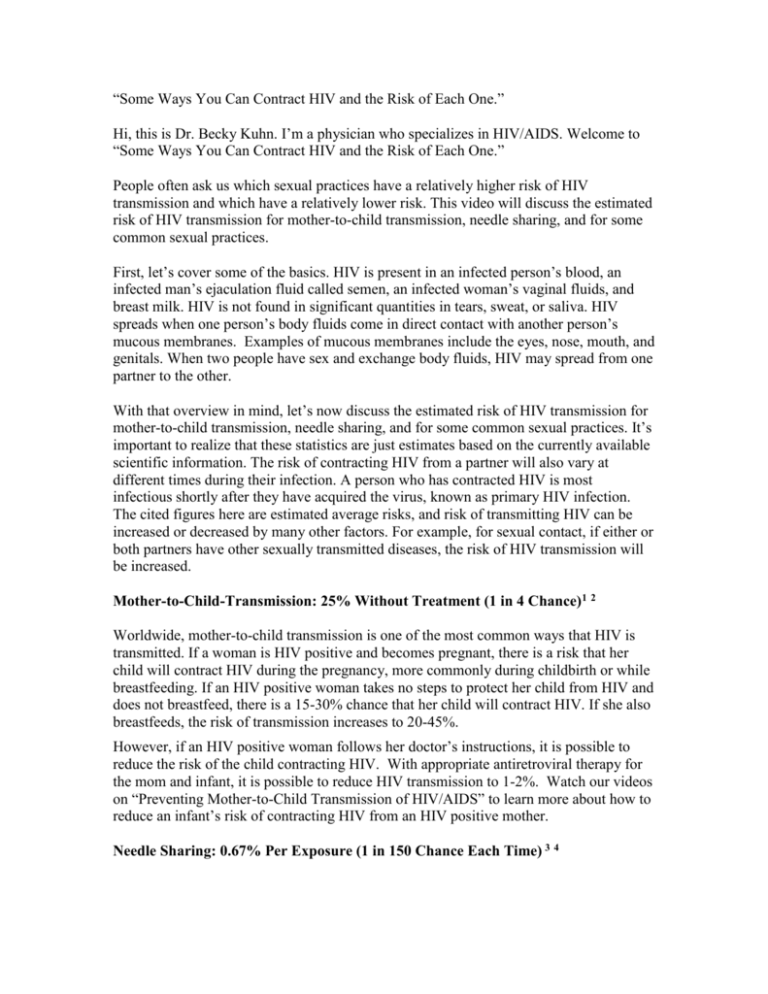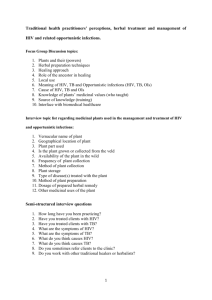
“Some Ways You Can Contract HIV and the Risk of Each One.”
Hi, this is Dr. Becky Kuhn. I’m a physician who specializes in HIV/AIDS. Welcome to
“Some Ways You Can Contract HIV and the Risk of Each One.”
People often ask us which sexual practices have a relatively higher risk of HIV
transmission and which have a relatively lower risk. This video will discuss the estimated
risk of HIV transmission for mother-to-child transmission, needle sharing, and for some
common sexual practices.
First, let’s cover some of the basics. HIV is present in an infected person’s blood, an
infected man’s ejaculation fluid called semen, an infected woman’s vaginal fluids, and
breast milk. HIV is not found in significant quantities in tears, sweat, or saliva. HIV
spreads when one person’s body fluids come in direct contact with another person’s
mucous membranes. Examples of mucous membranes include the eyes, nose, mouth, and
genitals. When two people have sex and exchange body fluids, HIV may spread from one
partner to the other.
With that overview in mind, let’s now discuss the estimated risk of HIV transmission for
mother-to-child transmission, needle sharing, and for some common sexual practices. It’s
important to realize that these statistics are just estimates based on the currently available
scientific information. The risk of contracting HIV from a partner will also vary at
different times during their infection. A person who has contracted HIV is most
infectious shortly after they have acquired the virus, known as primary HIV infection.
The cited figures here are estimated average risks, and risk of transmitting HIV can be
increased or decreased by many other factors. For example, for sexual contact, if either or
both partners have other sexually transmitted diseases, the risk of HIV transmission will
be increased.
Mother-to-Child-Transmission: 25% Without Treatment (1 in 4 Chance)1 2
Worldwide, mother-to-child transmission is one of the most common ways that HIV is
transmitted. If a woman is HIV positive and becomes pregnant, there is a risk that her
child will contract HIV during the pregnancy, more commonly during childbirth or while
breastfeeding. If an HIV positive woman takes no steps to protect her child from HIV and
does not breastfeed, there is a 15-30% chance that her child will contract HIV. If she also
breastfeeds, the risk of transmission increases to 20-45%.
However, if an HIV positive woman follows her doctor’s instructions, it is possible to
reduce the risk of the child contracting HIV. With appropriate antiretroviral therapy for
the mom and infant, it is possible to reduce HIV transmission to 1-2%. Watch our videos
on “Preventing Mother-to-Child Transmission of HIV/AIDS” to learn more about how to
reduce an infant’s risk of contracting HIV from an HIV positive mother.
Needle Sharing: 0.67% Per Exposure (1 in 150 Chance Each Time) 3 4
Another common route of HIV transmission is through the sharing of needles by
injection drug users. HIV is present in the blood of an infected person. If a person with
HIV uses a needle to inject a drug, some of their blood gets in and on the needle. If
another person uses that same dirty needle, the other person may contract HIV as a result.
According to an article by Edward Kaplan in the Journal of AIDS and Human
Retrovirology, each time a person is exposed to a needle with HIV, the risk of HIV
transmission is 0.67%. This means that if you inject yourself with a dirty needle 100
times, your risk of contracting HIV might be as high as 67%. If you inject drugs, the best
way to avoid contracting HIV is to use your own needles and not share them. Please also
talk to a doctor about getting into a treatment program to help you get clean.
Unprotected Receptive Anal Sex: 0.5% Per Exposure (1 in 200 Chance Each Time) 5
67
Anal sex is riskier than vaginal sex because the anal tissue is more prone to tearing during
sex than the vaginal tissue. If a person is the receptive (or “bottom”) partner in anal sex
and no condom is used, their risk of contracting HIV from an infected partner is
estimated to be 0.5% (1 chance in 200) per exposure, according to the European Study
Group on Heterosexual Transmission of HIV. This means that if you are the “bottom” in
unprotected anal sex with HIV infected partners 100 times, you may have a fifty-fifty
chance of having contracted HIV. If you engage in anal sex, use a condom every time to
reduce your risk of contracting HIV.
Unprotected Receptive Vaginal Sex: 0.1% Per Exposure (1 in 1000 Chance Each
Time) 8 9 10 11
If a man infected with HIV has unprotected vaginal sex with a woman, the woman has a
0.1% chance (1 in 1000 chance) per exposure of contracting HIV. Women’s genitalia
have a larger mucosal surface area than men. Overall, in vaginal sex, there is a greater
risk that HIV will be transmitted to the woman than to the man.
Unprotected Insertive Anal Sex: 0.065% Per Exposure (1 in 1538 Chance Each
Time) 12 13 14
If a man has unprotected insertive anal sex, or is a “top”, with a partner who is infected
with HIV, he has a 0.065% chance (1 in 1538 chance) of contracting HIV each time. As
in other sexual practices, using a condom correctly every time will greatly reduce his risk
of contracting HIV.
Unprotected Insertive Vaginal Sex: 0.05% Per Exposure (1 in 2000 Chance Each
Time) 15 16 17
If a man has unprotected insertive vaginal sex with a woman who is infected with HIV,
he has a 0.05% chance (1 in 2000 chance) of contracting HIV each time. It’s worth
repeating: using a condom correctly every time will greatly reduce your risk.
Unprotected Receptive Oral Sex on a Man: 0.01% Per Exposure (1 in 10,000
Chance Each Time) 18 19
Unprotected Insertive Oral Sex on a Man: 0.005% Per Exposure (1 in 20,000
Chance Each Time) 20 21
If a person performs oral sex on a man without using a condom, the person has a 0.01%
chance (1 in 10,000 chance) of contracting HIV each time. If a man has unprotected oral
sex performed on him without a condom by an HIV positive partner, he has a 0.005%
chance (1 in 20,000 chance) of contracting HIV each time.
Because these risks are relatively lower than some other practices such as insertive or
receptive anal sex, people sometimes think that “oral sex is safe sex.” It’s important to
realize that the risk of HIV transmission in either direction via oral sex is not zero, and
since there’s no cure for HIV once you’re infected, why take an unnecessary risk that
could change your life forever? Also realize that there are other sexually transmitted
diseases such as herpes, syphilis, and gonorrhea that can be transmitted via oral sex. So if
you have oral sex, use a condom each to reduce your risk of contracting HIV or other
sexually transmitted diseases.
Unprotected oral sex on a woman
It is difficult to predict the risk of HIV transmission for either partner when performing
oral sex on a woman. The Centers for Disease Control and Prevention has reported that
the risk for HIV transmission is low compared to vaginal and anal sex.22 It is important
to remember that there have been documented cases of HIV transmission likely occurring
from oral sex on a woman, so using protection like a dental dam is always a good idea to
decrease your risk of any STDs, including HIV.
Remember, the averages won’t help you if you’re the one who becomes infected. For
example, unprotected insertive oral sex on a man may carry an estimated risk of 1 chance
of HIV transmission in 20,000, but if you’re the one who gets infected, HIV transmission
is still 100% for you. These statistics are not a license to engage in unprotected sex.
Rather, they will hopefully help people to realize that all of the sexual practices we’ve
listed carry some risk of HIV transmission, so it’s vital if you’re sexually active to always
practice safer sex techniques such as the use of condoms.
No matter who you are, you are a valuable individual, and your life matters as do the
lives of those in your community. Take care of yourself and those around you. Make
healthy choices that eliminate or reduce your risk of contracting or transmitting HIV.
This is Dr. Becky Kuhn.
------------------This script was written by Eric Krock and Becky Kuhn, M.D.
This script was reviewed and approved for scientific and medical accuracy by Becky
Kuhn, M.D. on March 23, 2008.
“HIV,” Wikipedia, accessed 21 March 08, http://en.wikipedia.org/wiki/Hiv
Coovadia, H. (2004). "Antiretroviral agents—how best to protect infants from HIV and save their mothers
from AIDS". N. Engl. J. Med. 351 (3): 289-292. PMID 15247337
1
2
“HIV,” Wikipedia, accessed 21 March 08, http://en.wikipedia.org/wiki/Hiv
Kaplan, E. H. and Heimer, R. (1995). "HIV incidence among New Haven needle exchange participants:
updated estimates from syringe tracking and testing data". J. Acquir. Immune Defic. Syndr. Hum.
Retrovirol. 10 (2): 175-176. PMID 7552482
5
“HIV,” Wikipedia, accessed 21 March 08, http://en.wikipedia.org/wiki/Hiv
6
European Study Group on Heterosexual Transmission of HIV (1992). "Comparison of female to male and
male to female transmission of HIV in 563 stable couples". BMJ. 304 (6830): 809-813. PMID 1392708
7
Varghese, B., Maher, J. E., Peterman, T. A., Branson, B. M. and Steketee, R. W. (2002). "Reducing the
risk of sexual HIV transmission: quantifying the per-act risk for HIV on the basis of choice of partner, sex
act, and condom use". Sex. Transm. Dis. 29 (1): 38-43. PMID 11773877
8
“HIV,” Wikipedia, accessed 21 March 08, http://en.wikipedia.org/wiki/Hiv
9
European Study Group on Heterosexual Transmission of HIV (1992). "Comparison of female to male and
male to female transmission of HIV in 563 stable couples". BMJ. 304 (6830): 809-813. PMID 1392708
10
Varghese, B., Maher, J. E., Peterman, T. A., Branson, B. M. and Steketee, R. W. (2002). "Reducing the
risk of sexual HIV transmission: quantifying the per-act risk for HIV on the basis of choice of partner, sex
act, and condom use". Sex. Transm. Dis. 29 (1): 38-43. PMID 11773877
11
Bell, D. M. (1997). "Occupational risk of human immunodeficiency virus infection in healthcare
workers: an overview.". Am. J. Med. 102 (5B): 9-15. PMID 9845490
12
“HIV,” Wikipedia, accessed 21 March 08, http://en.wikipedia.org/wiki/Hiv
13
European Study Group on Heterosexual Transmission of HIV.
14
Varghese et al.
15
“HIV,” Wikipedia, accessed 21 March 08, http://en.wikipedia.org/wiki/Hiv
16
European Study Group on Heterosexual Transmission of HIV.
17
Varghese et al.
18
“HIV,” Wikipedia, accessed 21 March 08, http://en.wikipedia.org/wiki/Hiv
19
Varghese et al.
20
“HIV,” Wikipedia, accessed 21 March 08, http://en.wikipedia.org/wiki/Hiv
21
Varghese et al.
22
Centers for Disease Control and Prevention, “HIV/AIDS Update: Preventing the Sexual Transmission of
HIV, the Virus that Causes AIDS What You Should Know about Oral Sex,” December 2000,
http://www.cdc.gov/hiv/resources/factsheets/pdf/oralsex.pdf
3
4





